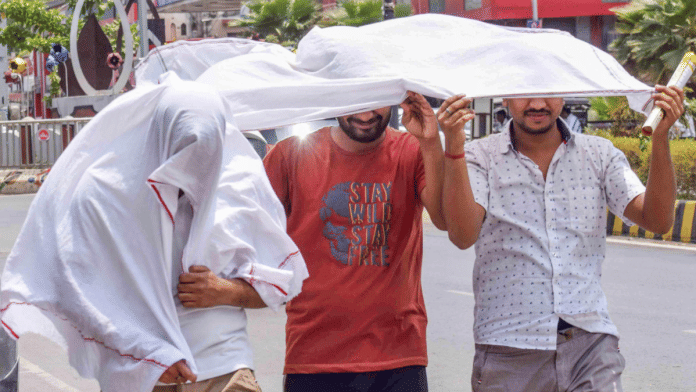New Delhi: Between June and August this year, India experienced its second-hottest period since 1970, with 112 million-plus people facing at least a month of potentially health-threatening temperatures in this quarter, according to a report by the US-based research organisation Climate Central.
The report, ‘People Exposed to Climate Change: June-August 2024,’ released Wednesday by Joseph Giguere and Andrew Pershing, climate experts at Climate Central, analyses how global temperatures were elevated due to climate change during this period.
“Over 20.5 million people experienced these temperatures exceptionally influenced by climate change for at least 60 days in the past three months, making India the Southern Asian country with the most people exposed to temperatures driven by climate change,” according to the supplementary information provided with the report.
“Over 426 million (nearly a third of the population) experienced at least 7 days of potentially risky temperatures—temperatures that were hotter than 90 percent of temperatures observed in a local area over the 1991-2020 period,” it says about India.
Globally, the scenario was no less alarming. Seventy-two countries experienced their hottest June-August period since at least 1970. The average person in these countries experienced a very strong influence of climate change on 34 of the 92 total days from June-August.
As for India, northwest and central India experienced one of the worst heat spells this year which broke an 80-year record for high temperature. The high temperatures were not just uncomfortable, but were deadly as well. As many as 360 heatstroke deaths have been reported from 17 states, according to the official data of the Union Ministry of Health and Family Welfare.
Hot weather and heat stress were identified as significant contributors to heat-related illnesses and fatalities, as reported in a 2021 Lancet study. This report said extreme heat events are increasingly becoming a constant aspect of summer seasons globally, leading to numerous additional deaths.
Researchers at Climate Central quantified climate change-induced temperature shifts using visually-aided predictive tools, the Climate Shift Index and Temperature Anomaly. They estimated the number of people experiencing “risky days” — days when the temperature recorded in any given area is higher than 90 percent of those recorded over a 30-year period (1991-2020) to predict risks of heat to human health.
On these particularly hot days, the risk of heat-related health problems, including fatalities, becomes significantly greater.
“Climate change boosted temperatures this summer across India. Over one billion Indians were exposed to more than a week of potentially dangerous heat, and eight states and union territories experienced their hottest summer since at least 1970,” Andrew Pershing, vice-president for science at Climate Central, told ThePrint.
He further said that the heat was especially intense in some of India’s cities, including Delhi, Lucknow, Chandigarh, which suffered through exceptional heat waves of at least one week. “Climate change made the hot conditions this summer more likely and more severe”.
Pershing warned that summers in India will continue to get hotter and more dangerous until the world stops burning coal, oil, and gas.
In Delhi and Kanpur, dangerously high temperatures exceeding 39 degrees Celsius were recorded for extended periods in the three-month period. The analysis estimates that climate change has made such extreme temperatures four times more likely.
Additionally, cities like Thiruvananthapuram, Vasai-Virar, Kavaratti, Thane, Mumbai, and Port Blair experienced elevated temperatures for 70 days or more, with climate change making these prolonged extremes three times more likely.
“High temperatures that were influenced by climate change jeopardised the health of billions around the world during the past three months,” Pershing said in a statement. “No region, country, or city is safe from the deadly threats posed by burning fossil fuels.”
(Edited by Tony Rai)






